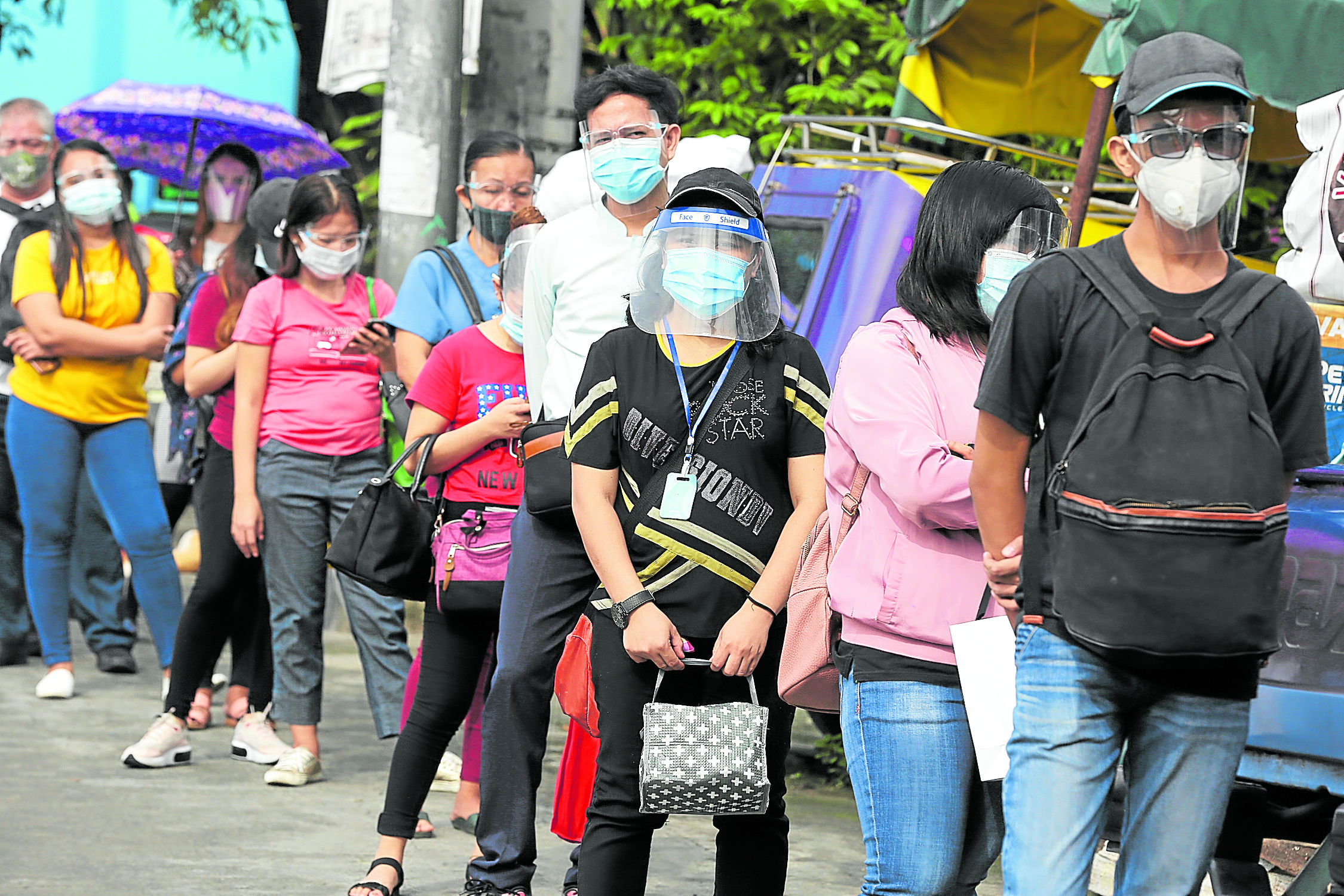
In this August 20, 2020, photo, passengers wear face shields and face masks along Commonwealth Avenue in Quezon City, as the Department of Transportation issued a memorandum directing all public transport passengers to wear face shields and face masks. This covers public transport passengers in the sectors of aviation, maritime, road, and railways, in a bid to ensure protection against the spread of the COVID-19. INQUIRER FILE PHOTO / NINO JESUS ORBETA
MANILA, Philippines — First, President Duterte told senators in a meeting that the ubiquitous plastic face shields should no longer be used in public places, except in hospital settings.
Then, his spokesperson said the shift in the policy of using face shields was not as simple as that, so people should wait for clarification before going around in public without wearing one.
According to Harry Roque, the Inter-Agency Task Force for the Management of Emerging Infectious Diseases (IATF) recommended to Duterte to continue requiring their use in enclosed or indoor spaces like hospitals, schools, workplaces, commercial establishments, public transport and terminals, and places of worship.
“While waiting for the President’s decision on the matter, the existing policy on the use of face shields remains in effect,” he said in a statement on Thursday.
In his meeting with senators on Wednesday, Duterte nixed the use of face shields in most instances, Roque said.
“I can only confirm what Senate President Tito Sotto and what Sen. Joel Villanueva said earlier that the President did say that the wearing of face shield should only be in hospitals,” he said.
He said the discussions between the President and the senators were about whether other countries also required the use of face shields to deal with the COVID-19 pandemic.
Mandatory since December
In December 2020, the Philippine government made the use of full-coverage face shields and masks mandatory in public places after the IATF approved their use in view of an expected surge in COVID-19 cases during and after the Christmas holiday.
Previously, a face shield was required only in specific places like malls or while riding public transportation.
Roque said the IATF can only make recommendations to the President.
“And when the President has decided, then that’s the policy,” he said.
Still, the IATF can appeal his decision, Roque said.
Expert advice
Nicanor Austriaco, a professor of biological sciences, said that if asked for his advice, he would recommend the use of face shields in high-risk areas, or those facing a surge in COVID-19 cases.
Austriaco said science suggests that face shields provide an added 9 percent protection against infection.
“Whether or not this 9 percent is worthwhile in the particular context really is a political prudential decision,” he said in a Palace briefing.
“The government has to decide exactly if that 9 percent is worth the sacrifice that the Filipino people would have to undertake,” he added.
Critics of the policy say the face shield requirement just poses an added financial burden. They also question its efficacy in preventing infections.
Manila Mayor Francisco “Isko Moreno” Domagoso said he was glad Duterte reconsidered the policy.
Domagoso earlier called on the IATF to scrap the policy saying face shields, which provided minimal protection when outside a hospital setting, only burden the poor with additional expenses during the pandemic.
Health Secretary Francisco Duque III had rejected a call to scrap the face shield requirement but Health Undersecretary Leopoldo Vega said face shields may be removed in outdoor settings where the risk of transmission is low.
Specific settings
Health Undersecretary Maria Rosario Vergeire clarified that the use of face shields is only required in specific settings, including enclosed public spaces or public spaces where one-meter physical distancing was not possible and there was a gathering of more than 10 people.
According to Senator Villanueva, who was present during the signing of a law in Malacañang on Wednesday, the President asked the senators to approach him and asked them about the face shields they were wearing.
“So, we made mention about what happened during the [Senate] hearing where it was also asked if there was any other country [that requires face shields],” Villanueva said on Thursday during a press briefing.
“But not one of us could say if there was any other country that made it a policy,” he said. “Then, the President himself said, ‘Then you don’t have to wear it.’ So, all of us took (them) off.”
In April this year, Peru made face shields mandatory in establishments with risk of crowding. —WITH A REPORT FROM MARICAR CINCO AND INQUIRER RESEARCH INQ